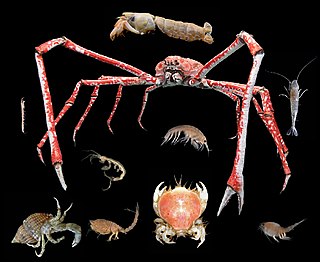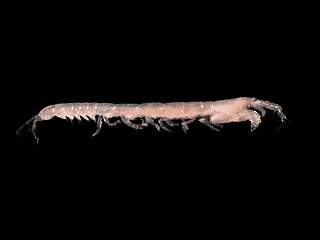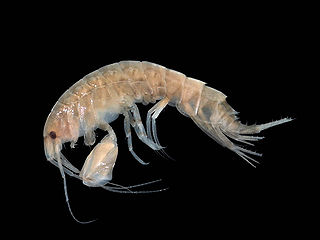
Dendrobranchiata is a suborder of decapods, commonly known as prawns. There are 540 extant species in seven families, and a fossil record extending back to the Devonian. They differ from related animals, such as Caridea and Stenopodidea, by the branching form of the gills and by the fact that they do not brood their eggs, but release them directly into the water. They may reach a length of over 330 millimetres (13 in) and a mass of 450 grams (1.0 lb), and are widely fished and farmed for human consumption.

Malacostraca is the largest of the six classes of crustaceans, containing about 40,000 living species, divided among 16 orders. Its members, the malacostracans, display a great diversity of body forms and include crabs, lobsters, crayfish, shrimp, krill, woodlice, amphipods, mantis shrimp and many other, less familiar animals. They are abundant in all marine environments and have colonised freshwater and terrestrial habitats. They are segmented animals, united by a common body plan comprising 20 body segments, and divided into a head, thorax, and abdomen.

Mysida is an order of small, shrimp-like crustaceans in the malacostracan superorder Peracarida. Their common name opossum shrimps stems from the presence of a brood pouch or "marsupium" in females. The fact that the larvae are reared in this pouch and are not free-swimming characterises the order. The mysid's head bears a pair of stalked eyes and two pairs of antennae. The thorax consists of eight segments each bearing branching limbs, the whole concealed beneath a protective carapace and the abdomen has six segments and usually further small limbs.

Isopoda is an order of crustaceans that includes woodlice and their relatives. Isopods live in the sea, in fresh water, or on land. All have rigid, segmented exoskeletons, two pairs of antennae, seven pairs of jointed limbs on the thorax, and five pairs of branching appendages on the abdomen that are used in respiration. Females brood their young in a pouch under their thorax.

The decapod crustacean, such as a crab, lobster, shrimp or prawn, is made up of 20 body segments grouped into two main body parts: the cephalothorax and the pleon (abdomen). Each segment may possess one pair of appendages, although in various groups these may be reduced or missing. They are, from head to tail:

The crustacean order Tanaidacea make up a minor group within the class Malacostraca. There are about 940 species in this order.

Cumacea is an order of small marine crustaceans of the superorder Peracarida, occasionally called hooded shrimp or comma shrimp. Their unique appearance and uniform body plan makes them easy to distinguish from other crustaceans. They live in soft-bottoms such as mud and sand, mostly in the marine environment. There are more than 1,500 species of cumaceans formally described. The species diversity of Cumacea increases with depth.

Triops longicaudatus is a freshwater crustacean of the order Notostraca, resembling a miniature horseshoe crab. It is characterized by an elongated, segmented body, a flattened shield-like brownish carapace covering two thirds of the thorax, and two long filaments on the abdomen. The genus name Triops comes from Ancient Greek ὤψ or ṓps, meaning "eye" prefixed with Latin tri-, "three", in reference to its three eyes. Longicaudatus is a Latin neologism combining longus ("long") and caudatus ("tailed"), referring to its long tail structures. Triops longicaudatus is found in freshwater ponds and pools, often in places where few higher forms of life can exist. Like its relative Triops cancriformis, the longtail tadpole shrimp is considered a living fossil because its basic prehistoric morphology has changed little in the last 70 million years, exactly matching their ancient fossils. Triops longicaudatus is one of the oldest animal species still in existence.

Neomysis is a genus of opossum shrimp from the family Mysidae, distributed in the coastal zone of temperate seas of the Northern Hemisphere and South America. Several species, particularly from the West Pacific, are also found in fresh and brackish waters. The genus contains the following 18 species:

Praunus flexuosus, known as the chameleon shrimp, is a species of opossum shrimp found in European waters. It reaches 26 mm (1.0 in) long, with a distinctly bent body, and closely resembles Praunus neglectus. It lives in shallow water and tolerates a wide range of salinities. It is found from northern France to the Baltic Sea, and was introduced to North America in the mid 20th century.

Caprella mutica, commonly known as the Japanese skeleton shrimp, is a species of skeleton shrimp. They are relatively large caprellids, reaching a maximum length of 50 mm (2.0 in). They are sexually dimorphic, with the males usually being much larger than the females. They are characterized by their "hairy" first and second thoracic segments and the rows of spines on their bodies. Body color ranges from green to red to blue, depending on the environment. They are omnivorous highly adaptable opportunistic feeders. In turn, they provide a valuable food source for fish, crabs, and other larger predators. They are usually found in dense colonies attached to submerged man-made structures, floating seaweed, and other organisms.
Mysis salemaai is a shrimp-like crustacean in the Mysida order, inhabiting lakes of Ireland and South Scandinavia and brackish waters of the northern Baltic Sea.
Heteromysis actiniae, commonly known as the anemone mysid, is a species of opossum shrimp from the genus Heteromysis found in association with the sea anemone Bartholomea annulata. It is found in the Caribbean Sea and the Gulf of Mexico.

Crustaceans form a large, diverse arthropod taxon which includes such animals as crabs, lobsters, crayfish, shrimps, prawns, krill, woodlice, and barnacles. The crustacean group can be treated as a subphylum under the clade Mandibulata; because of recent molecular studies it is now well accepted that the crustacean group is paraphyletic, and comprises all animals in the clade Pancrustacea other than hexapods. Some crustaceans are more closely related to insects and the other hexapods than they are to certain other crustaceans.
Americamysis bahia is a shrimp-like crustacean in the order Mysida, the opossum shrimps. It is native to estuarine waters in Texas and Florida in the United States. It is often referred to in the literature as Mysidopsis bahia and is widely cultured and used in the laboratory for toxicology testing.

Gastrosaccus spinifer is a shrimp-like crustacean in the order Mysida, the opossum shrimps, native to the eastern Atlantic Ocean and the coasts of Northern and Western Europe.
Prodajus ostendensis is a species of marine isopod in the family Dajidae and is found in the North Sea. It is an ectoparasite of the opossum shrimp Gastrosaccus spinifer. It is normally found living in the host's marsupium and devouring its eggs.

Squilla empusa is a species of mantis shrimp found in coastal areas of the western Atlantic Ocean. It excavates and occupies a burrow in soft sediment from which it emerges, mainly at night, to feed on fish and invertebrate prey.

Caprella equilibra is a species of skeleton shrimp in the family Caprellidae. It lives among other organisms on the seabed and occurs in both shallow and deep water in many parts of the world.

Caprella penantis is a species of skeleton shrimp in the family Caprellidae. It lives on the seabed in shallow water in many parts of the world. This species was first described in 1814 by the English zoologist William Elford Leach who named it Caprella penantis in honour of the Welsh naturalist Thomas Pennant. The type locality is Devon, England.
















